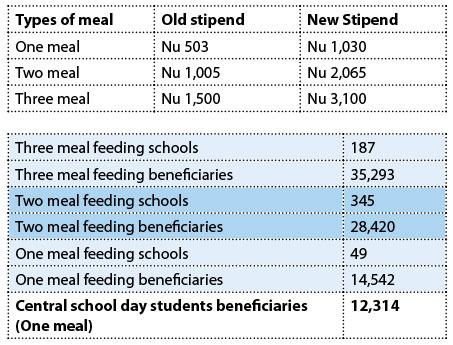July 21, 2025
THIMPHU – More than 90,000 students across Bhutan will receive increased school meal stipends beginning this month, following a Cabinet decision aimed at combating rising concerns over child malnutrition.
The revised stipend rates were approved during the 50th session of the Fourth Lhengye Zhungtshog on May 15, after the Cabinet endorsed the proposal submitted by the Ministry of Education and Skills Development (MoESD).
While the Ministry had recommended Nu 3,400 per child for students receiving three meals daily, the Cabinet approved Nu 3,100, citing fiscal considerations. Officials, however, stressed that the increase remains a crucial step in improving student nutrition.
With this decision, the stipend for boarders receiving three meals a day has been increased from Nu 1,500 to Nu 3,100 per child per month. Students receiving two meals daily will now receive Nu 2,065, while day scholars and others receiving one meal will receive Nu 1,035.

VISUAL: KUENSEL
“The government recognises that proper nutrition is essential for learning and development,” an official from the ministry said. “This increase reflects the ministry’s commitment to ensuring that every child receives adequate nutrition to support their education.”
According to MoESD, the revised stipend was informed by a national nutrition survey conducted by the Ministry of Health, which revealed widespread deficiencies in essential micronutrients including Vitamin D, B12, ferritin, and folate among school-aged children.
“We did not propose this amount blindly,” said an official from the Health and Wellbeing Division. “The proposed amount was developed in consultation with a World Food Programme (WFP) nutritionist using the School Menu Plan Plus tool, which aligns menu costs with the nutritional needs of children by average age group.”
The national nutrition survey found that 8.8 percent of children under five are underweight, 5.1 percent are too thin for their height, and 17.9 percent are stunted—too short for their age—indicating chronic malnutrition.
As of June 2025, Bhutan has 467 feeding schools serving 90,569 students. Among them, 187 schools provide three meals a day for 35,293 students; 345 schools serve two meals to 28,420 students; 49 schools offer one meal to 14,542 students; and central schools provide one meal to 12,314 students.
The education ministry has also introduced a school meal menu designed to meet dietary needs across age groups. The menu will be reviewed periodically based on student and school feedback. Tea has been removed from school menus on the recommendation of the health ministry and replaced with fortified milk to improve nutritional intake.
Most of the revised stipend will go directly to schools for the procurement of perishable items such as vegetables, dairy, and meat. The remainder will be used for centrally procured non-perishable goods supplied by the Food Corporation of Bhutan Limited (FCBL).
To ensure compliance with nutritional standards, the Health and Wellbeing Division under the MoESD oversee implementation and carry out ad hoc inspections.
Officials say the strengthened monitoring and revised menu framework reflect the government’s resolve to address childhood malnutrition and its long-term effects on education, growth, and cognitive development.


